The observer camp
Pictures on this page were taken during a three days trip in Zambia specially organized for the 06-21-2001 solar eclipse by Nouvelles Frontieres and Corsair companies.
The camp (14° 50' 11"S 28° 01' 11"E) is in the bush at Balla-Balla estates near the Chisamba town. It is located just in the middle of the path of totality, 50 km northward from Lusaka .

About 350 participants are standing in the camp, sheltered by tents. A barbed wire fence is surrounding the camp, protected by zambian security guards, very intrigated by our various equipments.
Observation conditions are excellent. The sky is perfectly clear. Some wind gusts force observers to shelter their equipments in order to prevent vibrations.

Photographic equipment
My equipments placed in tne proximity of a bus acting as a wind screen, are composed as follows:
- a Meade ETX90 telescope with an
EPSON PC3000Z digital camera standing in afocal mode behind a SP
40mm eyepiece.
- 15x80 binoculars with glass filters fixed on a tripod.
- a second EPSON PC600 digital camera intended for landscape
photography.
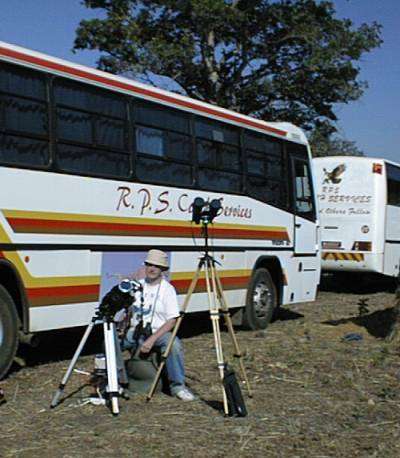
The optical zoom of the digital camera is adjusted at x1.5. The eclipsed sun appears below on the monitoring screen of the digital camera, allowing manual sun tracking throug the ETX-90 keypad. The digital camera is powered by a 12AH lead-acid battery (a heavy weight in our luggage!).
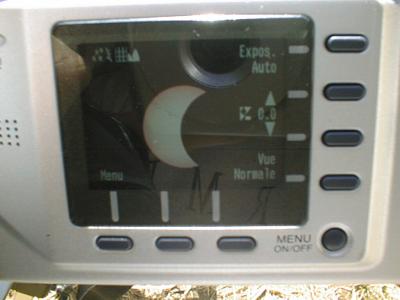
The sun just before the eclipse starts
For a few days, the sun has been exhibiting huge spots, improving the eclipse background.
After the 1rst contact
The first contact occurs at 13H40 local time. The lunar disk is progressively swallowing all the sun spots.
Changing shadows
The light of the eclipsed sun crossing tree leaves creates an amazing multitude of crescent shaped patterns.
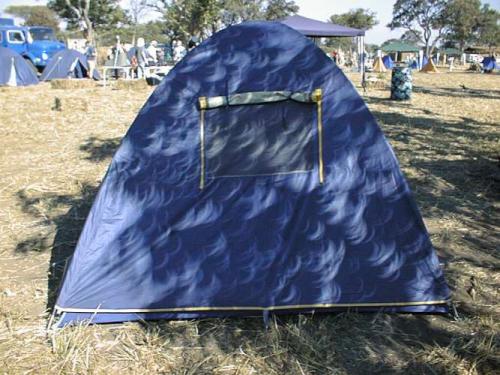
Last moments before second contact
Observers are ready to remove sun filters from their instruments. Second contact occurs at 15H10 local time.
The solar corona
A bright and thick corona appears after the second contact. Exposure time is 1/60 second. On the left side is a raw picture. The right picture has been transformed by a wavelet filter using IRIS software in order to enhance coronal ejections. Notice the curled patterns on the right side of the corona.
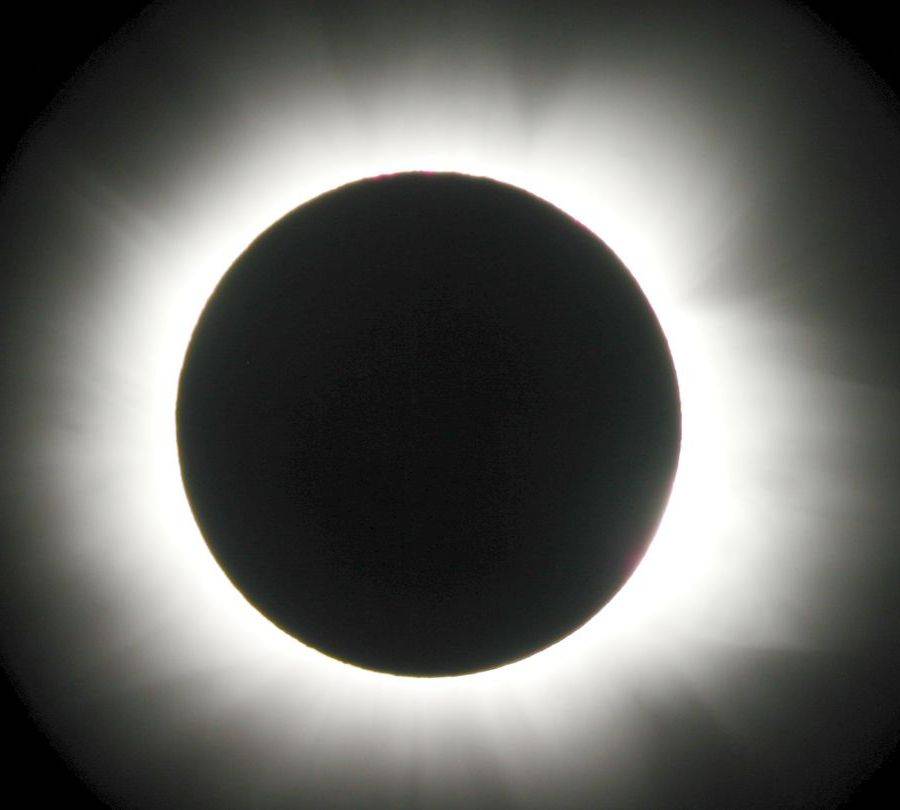 |
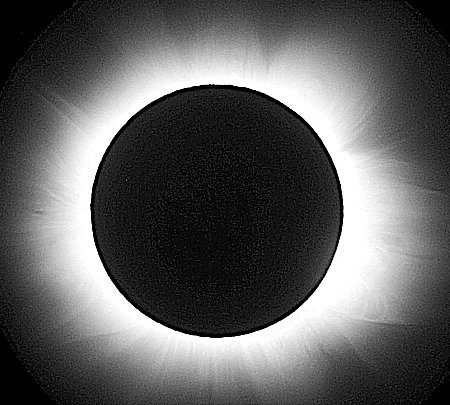 |
![]() A 3D view of the total eclipse
A 3D view of the total eclipse
This 3D view is an anaglyph
composed of two pictures captured 80 seconds apart during the
totality.
Click and Try with your 3D glasses ....
Below is a detailed view of the upper side of the lunar limb showing the outline of the lunar relief in front of the bright corona.

Prominences
Exposure time is set at 1/150 second. At least 6 main reddish prominences are distributed around the lunar limb.
 This
movie reveals prominences moving behind the lunar limb (640x573
GIF format176K)
This
movie reveals prominences moving behind the lunar limb (640x573
GIF format176K)
This movie is composed of three
pictures with a time lapse of about 40 seconds between
consecutives pictures.
Landscape
These two pictures below show the
same landscape shortly before and shortly after the totality.
On the second picture, Jupiter is visible on the lower left side
of the black sun. Amber color is stretching along the horizon.
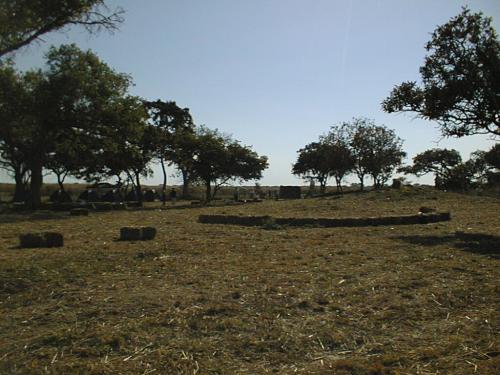
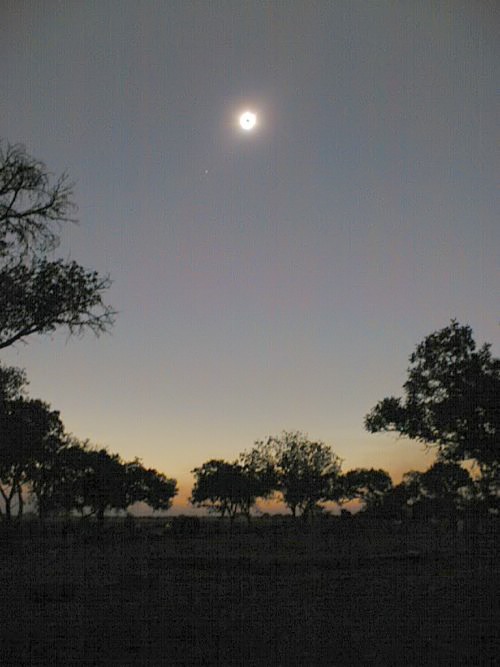
Second diamond ring
A 1/200 second exposure is made after the beginning of the second diamond ring pattern. Excessive enlightment creates parasitic shimmering on the camera lenses though prominences are still visible.
After the third contact
After 3 minutes and 30 seconds elapsed too briefly, the third contact occurs at 15H13 local time.
The last contact
The last contact occurs at 16H27
local time. At this moment, It is time for us to pack our
luggage, step in the bus and drive to Lusaka airport.
9 hours later, we are back in Paris with wonderful memories of
this extraordinary phenomenon.
Comparison between diameters
Picture below is a numeric addition of one picture taken during the totality and one picture taken before the eclipse starts. This addition gives an idea of the relative difference between the sun diameter and the moon diameter at the eclipse time.
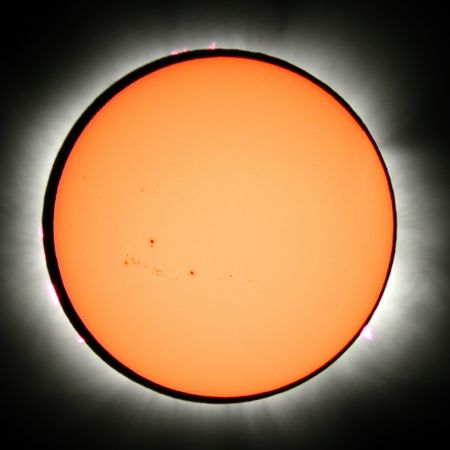
 full
eclipse movie (640x573 GIF format 1607K)
full
eclipse movie (640x573 GIF format 1607K)
This movie is made of about 60 pictures (average time lapse between consecutive picture is 3 minutes).
Satellite movie of the eclipse